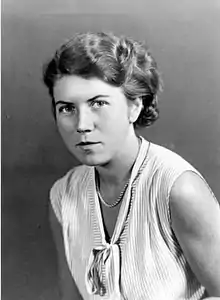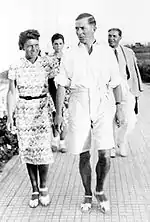Maria Terwiel
Maria Terwiel (7 June 1910 in Boppard – 5 August 1943 in Plötzensee Prison, Berlin) was a German resistance fighter who was a member of the anti-fascist resistance group that was later called the Red Orchestra by the Gestapo.[1]
Maria Terwiel | |
|---|---|
 Maria Terwiel as a younger women. | |
| Born | 7 June 1910 |
| Died | August 5, 1943 (aged 33) |
| Cause of death | Guillotine |
| Nationality | German |
Life

Her father Johannes Terwiel was a devout Catholic and beamter in the office of the regional commissioner in the Pomeranian government and her mother Rosa was Jewish.[2] Her father was Social Democrat who was dismissed from his job in 1933 by the Nazis.[2]
Maria completed her Abitur at a Gymnasium in Stettin in 1931.[3] She studied law in Freiburg (Baden-Württemberg) and Munich. During her studies, she got to know her future fiancé Helmut Himpel, who was a dentist. However, under the Nuremberg Laws, she was deemed to be a "Half-Jewess" ("Halbjüdin"), which meant that the outlook for her getting a job as a junior attorney (Rechtsreferendarin) was rather grim. She and Himpel were forbidden to marry. After giving up her studies, she lived with Helmut Himpel in Berlin after her father had lost his job in 1933 after the Nazis had come to power. In a German-Swiss textile company, she found a job as a secretary.[4]
The devout Catholic, along with Helmut Himpel, helped Jews in hiding, to whom they furnished identification and ration cards. There arose contacts with the Red Orchestra group about Harro Schulze-Boysen. Terwiel wrote illegal handbills and put up posters against the Nazi propaganda exhibition "Soviet Paradise".[4]
After her arrest on 17 September 1942, Maria Terwiel was sentenced to death on 26 January 1943 by the Reichskriegsgericht ("Reich Military Tribunal"). She was put to death at Plötzensee Prison in Berlin.
Literature
- Roloff, Stefan (2002). Die Rote Kapelle. Die Widerstandsgruppe im Dritten Reich und die Geschichte Helmut Roloffs (in German). Berlin: Ullstein. ISBN 3-548-36669-4..
- Pruß, Ursula (2014), Maria Terwiel. In: Helmut Moll, (ed.), Zeugen für Christus. Das deutsche Martyrologium des 20. Jahrhunderts, Paderborn, vol. I, pp 146-149. ISBN 978-3-506-78080-5
- Tuchel, Johannes (1994), Maria Terwiel und Helmut Himpel. Christen in der Roten Kapelle. In: Hans Coppi junior, Jürgen Danyel, Johannes Tuchel (eds): Die Rote Kapelle im Widerstand gegen den Nationalsozialismus, Berlin: Edition Hentrich. ISBN 3894681101, p. 213-
References
- "Maria Terwiel". Gedenkstätte Deutscher Widerstand. German Resistance Memorial Center. Retrieved 14 September 2019.
- Women and War: A Historical Encyclopedia from Antiquity to the Present. 2 (1 ed.). ABC-CLIO. 2006. p. 585. ISBN 978-1-85109-770-8. Retrieved 14 September 2019.
- "Maria Terwiel". Koordinierungsstelle Stolpersteine Berlin (in German). Berlin: AG Stolpersteine Reinickendorf. Retrieved 14 September 2019.
- Tuchel, Johannes (1988). "Weltanschauliche Motivationen in der Harnack/Schulze-Boysen-Organisation: („Rote Kapelle")". Kirchliche Zeitgeschichte. 1 (2): 267–292.